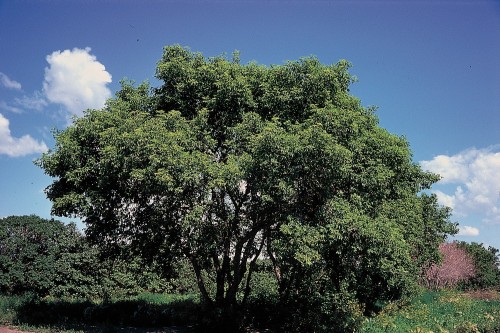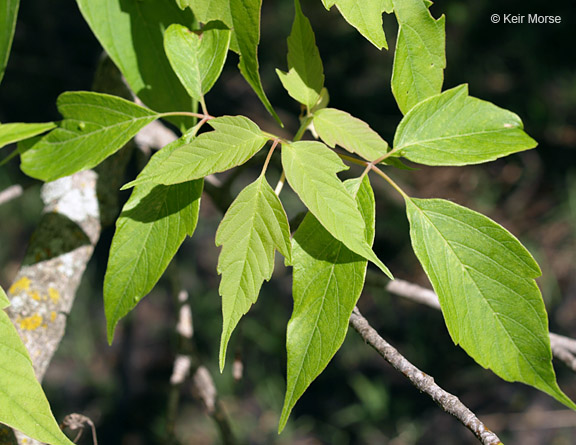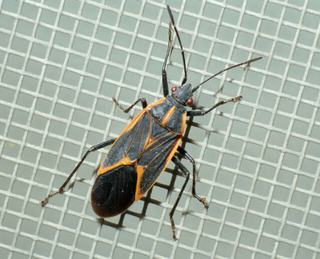Boxelder
(Acer negundo L.)
Description
Box elder, also known as the ash-leaved maple, maple ash, or Manitoba maple, is a medium-sized (35-70 feet tall), deciduous tree with an average lifespan between sixty and seventy-five years, but are capable of reaching up to one hundred years under optimal conditions¹. When given ample room to grow, box elders take on an irregular shape with their trunk quickly splitting into multiple, widespread branches². This pattern of growth results in a broad treetop resembling large shrubbery due to the shorter, stockier build taken on by the tree in the abundance of space². Commonly, the tree to form multiple trunks. When grown in close proximity to other trees, branches do not grow as drastically in a lateral direction and will instead create a narrower tree reaching the upper end of the species’ height range. Boxelder is a member of the soapberry family (Sapindaceae).

Box elder habit. Lakeforest.edu13

Box elder leaves. @Ken Morse, CalPhotos 14
The leaves of the box elder are unlike those of most other trees in the genus Acer. The box elder is the only tree in the genus that produces pinnately compound leaves¹. The leaves are opposite with an odd number of leaflets, typically five but between three and seven leaflets per petiole¹. The edges of the leaflets may be smooth or have a few large teeth and reach a maximum size of approximately four inches in length². As the seasons change, these leaves turn pale green/yellow and will drop off sporadically throughout the colder months of the year².
First and second year twigs remain green, but as the tree continues to age, the bark develops hard ridges and takes on a darker gray/brown hue.
The box elder produces unisexual flowers that form in drooping clusters of plant matter. Each tree produces flowers with either stamens or carpels, but, as with all dioecious plants, both cannot be found on the same tree (dioecious)¹. The fruit of the box elder grows in pairs of fused samaras, colloquially known as helicopters, that hang from the tree in long chains². These samaras mature in the later part of the year, detach from the tree in late winter, separate from one another, and then autorotate to the ground². The flattened wing design of the samara allows wind to carry the seeds a significant distance from their point of origin as they spiral downward. This method allows for seed dispersal beyond the range exhibited by trees that simply drop their seeds, thus increasing the distance between parent trees and their progeny.
 Male flowers of box elder. @ Ken Morse 2016, CalPhotos15
Male flowers of box elder. @ Ken Morse 2016, CalPhotos15

Female flowers of box elder. @ Ken Morse 2016. CalPhotos16

Fruits of box elder. @ Ken Morse 2016. CalPhotos17
Distribution
The box elder is present in every state of the contiguous U.S., with the majority of the population growing in the eastern half of the country¹. It is also an stablished species in the Canadian provinces of Alberta, British Columbia, Manitoba, New Brunswick, Nova Scotia, Northwest Territories, Ontario, Prince Edward Island, Quebec, and Saskatchewan¹. There ave been reports of box elder populations throughout Mexico and the species has reportedly been seen as far south as Guatemala³. Within these regions, the box elder grows in moist, wooded habitats primarily near streams, riverbanks, and floodplains¹. The box elder maintains canopy dominance at higher elevations due to the tree’s ability to survive a wider range of ecological variables, While brittle and easily broken by wind or ice, box elders are extremely drought resistant, cold resistant, and more tolerant to wide soil pH ranges than other trees³. At lower altitudes, the box elder shares canopy dominance with the green ash (F. pennsylvanica) ), willow (Salix), the bur oak (Quercus. macrocarpa), and several species of poplar (Populus) ².
Locally, the box elder can be found in relative abundance throughout Maryland except in Garrett County11 . The current largest known box elder in the United States, as of September 13th, 2019, is located in Frederick, MD and boasts an overall height of 69 feet, crown spread of 83.5 feet, and an overall tree circumference of 222 inches (18.5 feet)4 . Beyond the North American distribution, where it is considered a native species, the box elder has been introduced to (or invaded) every other continent with the exception of Antarctica.

Native distribution of box elder. USDA18
Wildlife Importance
Due to the trees large range, the box elder plays an important ecological role in the lives of an array of animal species all across North America. Boxelder beetles (Boisea trivittata) use the trees for food and habitat, the Cecropia silk moth (Hyalophora cecropia) uses the box elder as a larval host, and honeybees consume the nectar and pollen of the box elder². Many birds and mammals use the box elder as well. Deer and livestock use the trees for shade and
browse while birds and squirrels use them for nesting locations and seeds². While countless animals consume various parts of the box elder tree, there are reports that the tree’s toxicity, largely stemming from the hypoglycin A in the seeds, may outweigh the nutritional value for most larger animals, particularly horses².
Economic Importance
The box elder serves little role in terms of economic value. Due to the fragility and close graining of its wood, the tree is mainly used for making boxes, fiber board, and cheap furniture². The wood also has a relatively poor heat value so the demand for it as firewood is fairly low³. The primary commercial roles that box elders serve are in the effort to control wind erosion in rural areas and in meeting landscaping/aesthetic needs in cityscapes and suburban areas5.
Threats
In terms of conservation status, the box elder is not considered to be threatened whatsoever as it is abundantly found around the globe (natively in North America, invasively elsewhere)5. As a species, the trees are being impacted by factors that affect all botanical organisms (climate change, pollution, deforestation,
etc.), but nothing specific to only the box elder.
On an individual basis, single box elders may be threatened by a variety of biotic disruptions. One of the most common organisms found to capitalize on box elders are Rosy Maple Moths (Dryocampa rubicunda)6. These bugs lay their eggs on the leaves of the tree and then, upon larval hatching, they consume the leaves which can cause defoliation when the moths occur in sizable populations6.
An invasive beetle, the Asian Long-horned Beetle (A. glabripennis), has also chosen the box elder as one of the preferred homes for their North American populations5. Other insects, such as the cottony maple leaf scale, bladder mites, and the boxelder gall midge can create sizable galls (abnormal tumor-like growths on external tissues of plants) and legions all throughout the tree foliage². Another common inhabitant is the Boxelderug (Boisea trivittata) that feeds on the fruits of maples and ashes. It becomes a nuisance around houses and structures in the fall when seeking overwintering sites.12

Rosy Maple Moth. @ Barry Rice 2009. CalPhoto19

Boxelder Bug. University Minnesota12
Interesting Facts
- While it is a maple, box elder is “the least productive maple” when it comes to tapping the tree for maple syrup¹.
- Horticulturists have developed countless variants of the box elder: “Flamingo” which produces pink and white leaf variegation; “Pendulum” which grows weeping branches; “Violaceum” with blue shoots/branches and pink leaves; etc7.
- There is well-documented history of Native American tribes using box elder as a means to create tools (pipes, bowls, etc.), for fire to cook food, as incense/medicine/emetics, as well as using the sap to obtain syrup and sugar8. However, in1931, several Anasazi flutes were discovered in Northeastern Arizona which dated back to the seventh century, over 1000 years prior to Native American woodwork9. These flutes were made entirely of box elder wood9.
- Box elder seeds, and specifically the Hypoglycin A found within them, have been cited as the cause of Seasonal Pasture Myopathy (a muscular disease with a 90% fatality rate) in horses10.
- Upon consumption of a significant quantity of box elder seeds, the horse’s respiratory, postural, and cardiac muscles immediately begin to deteriorate resulting in a series of rapidly evolving symptoms before the inevitable death of the horse10.
References
- Lady Bird Johnson Wildlife Center: Acer negundo
- USDA-Forest Service, Fire Effects Information System: Acer negundo
- University of Tennessee Forest Resources AgResearch and Educatin Center: Acer negundo
- Champion Tree National Register
- Red List: Boxelder
- iNaturalist: Rosey Maple Moth
- Weeds of Australia: Acer negundo
- 27 Trees to tap for Maple Syrup
- Flutopedia: Anasazi Flutes from the Broken Flute Cave
- University of Minnesota: Boxelder seeds cause seasonal pasture myopathy in horses
- Maryland Biodiversity Project: Box elder
- Boxelder Bugs, University of Minnesota Extension
- Lake Forest College: Acer negundo
- CalPhotos: Acer negundo
- CalPhotos: Acer negundo
- CalPhotos: Acer negundo
- Boxelder Fruits, CalPhotos
- USDA-Forest Service Sylvics, Vol. 2, Hardwoods: Acer negundo
- Rosy Mosh, CalPhotos
Contributed by F. Schilling and T. Smith
